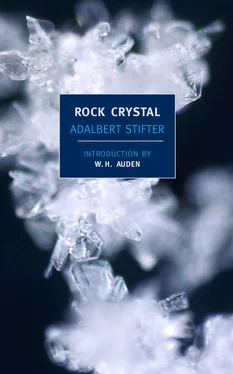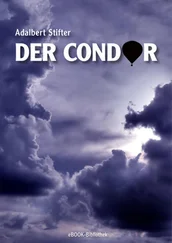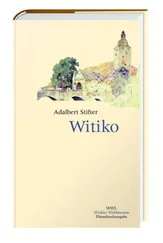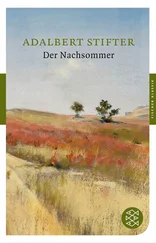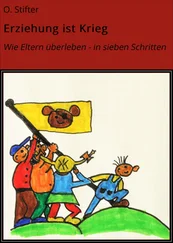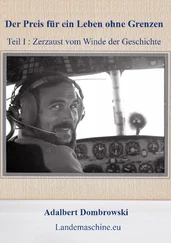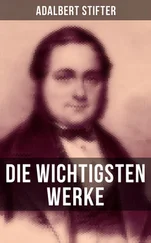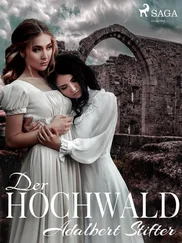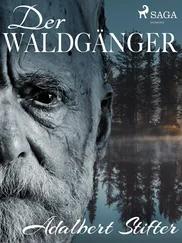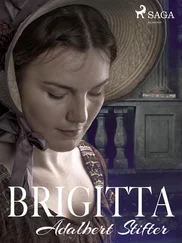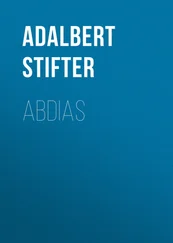Adalbert Stifter
Rock Crystal
ADALBERT STIFTER (1805–1868), the son of a provincial linen weaver and flax merchant, was born in the rural Bohemian market town of Oberplan, then part of the Austrian Empire but today in the Czech Republic. When Stifter was still a child, his father was crushed under an overturned cart; the family was left poor, but Stifter’s grandfather sent him to school at the the Benedictine Monastery of Kremsmunters and he proved a brilliant student. Stifter attended the University of Vienna, where he studied law but failed to obtain a degree. Instead he supported himself as a much sought-after tutor to the children of the high Viennese aristocracy while also acquiring a small reputation as a landscape painter. For a number of years Stifter eagerly courted the daughter of a rich businessman, but his lack of worldly position turned her family against him, and in 1835 he married Amelia Mohaupt, a milliner. In 1840, he published his first story, the success of which started him on a career as a writer, and in 1850, after working as an editor on two newspapers, he was appointed supervisor of elementary schools for Upper Austria. Stifter’s works include numerous stories and novellas, as well as Witiko , a historical novel, and Indian Summer , considered one of the finest examples of the German bildungsroman. Stifter’s mental and physical health deteriorated in his final years. In 1868, suffering from cirrhosis of the liver, he committed suicide.
W. H. AUDEN (1907–1973) was born in North Yorkshire, England, the son of a doctor. He studied at Oxford and published his first book, Poems , in 1930, immediately establishing himself as one of the outstanding voices of his generation. Auden emigrated to New York in 1939, where he became a United States citizen and converted to Anglicanism. He wrote essays, critical studies, plays, and opera librettos for such composers as Benjamin Britten, Igor Stravinsky, and Hans Werner Henze, as well as the poems for which he is most famous.
ADALBERT Stifter is generally considered one of the great German stylists. The son of a linen weaver, Stifter was born in the Bohemian village of Oberplan in 1805, educated in a Benedictine monastery and at the University of Vienna and became an inspector of schools. All his life he suffered from fits of depression and anxiety; one of his adopted daughters died of typhus, the other, for no apparent reason, drowned herself in the Danube; in 1868, ill and discouraged by the public indifference to his two big novels, Nachsommer and Witiko , he cut his throat.
As might be expected from a man of his temperament, he loved tradition, order, childhood and the limpid serenity of the classical style. He never traveled without a volume of Goethe in his pocket and shared his master’s interest in natural history and geology; he was also a charming landscape painter. His prose may remind an English reader of W. H. Hudson.
The plot of Rock Crystal is simple enough. Two children walk from one mountain valley to visit their grandparents on Christmas Eve. On their way home it starts to snow; they miss the path and when night falls they are far out on a glacier. They take shelter in an ice cave and are saved from falling asleep and freezing to death by some black coffee extract their grandmother has given them to carry home, which stimulates their bodies, and by a wonderful discharge of electric flashes in the sky which excites their minds. In the Christmas morning they are found by a search party and brought down the mountainside home to their rejoicing parents.
To bring off, as Stifter does, a story of this kind, with its breathtaking risks of appalling banalities, is a great feat. What might so easily have been a tear-jerking melodrama becomes in his hands a quiet and beautiful parable about the relation of people to places, of man to nature.
He achieves this result by a sort of fugal repetition of descriptive details. The two valleys with their inhabitants, the road over the col past the baker’s memorial, the way up to the mountain and the glacier are first presented objectively as if to a tourist or a historian, so that the reader knows where everything is and what everybody does. He knows, for instance, that love for the daughter of the wealthy dyer of Millsdorf made the restless young cobbler of Gschaid settle down to making mountain boots, but that she, who came over the hill to marry him, is still regarded as an outsider.
The same road over the col is traveled again, and again in the daylight, but this time by young children who have never been up the mountain. Consequently, when the crisis comes, while the appearance of the mountain by night is as unfamiliar to the reader as it is to the children, he has been there before with a guide, he knows where and how they are lost, and this knowledge heightens his awareness of Conrad’s courage and common sense and Sanna’s simple faith in her brother which overcomes all fear.
Finally the story returns to the panorama from which it started, but though everything looks the same, the eye that sees them is full of memories and no longer disinterested. The mountain is not only beautiful, but dangerous and lovable because its dangers have been met with courage. The road over the col is no longer taken for granted, but is seen as a triumph of the human will to neighborliness over an indifferent or hostile nature which would keep men estranged. Home has become really home for the first time, through the experience of being lost. The community, through having responded in common to a threat to some of its members, has realized itself completely:
Only from that day on were the children really felt to belong to the village and not to be outsiders. Thenceforth they were regarded as natives whom the people had brought back to themselves from the mountain. Their mother, Sanna, was now a native of Gschaid, too.
The children, however, can never forget the mountain and earnestly fix their gaze upon it when in the garden, when as in times past the sun is out bright and warm, the linden diffuses its fragrance, the bees are humming, and the mountain looks down upon them as serene and blue as the sky above.
The translation by Elizabeth Mayer and Marianne Moore reads like an original: that they should have managed this with an author who, like Flaubert, worried over every word, is testimony to their patience no less than to their skill.
— W. H. AUDEN
November 1945
THE CHURCH observes various festivals that are ever dear to the heart. What more gracious than Whitsuntide: more sacred or of deeper significance than Easter. The portentous sadness of Holy Week and exaltation of the Sunday following, accompany us throughout life. One of the most beautiful of Church festivals comes in midwinter when nights are long and days are short, when the sun slants toward earth obliquely and snow mantles the fields: Christmas. In many countries the evening that precedes our Lord’s nativity is known as Christmas Eve; in our region we call it Holy Eve, the day following Holy Day, and the night between, Holy Night. The Catholic Church observes Christmas, birthday of our Saviour, by magnificent and holiest ceremonial. In most places, midnight as the very hour of his birth is solemnized by ritual of great splendor, to which the bells ring out their heartsome invitation through the still darkness of the wintry air; then with their lanterns, along dim familiar paths, from snow-clad mountains, past forest-boughs encrusted with rime, through crackling orchards, folk flock to the church from which solemn strains are pouring, — the church rising from the heart of the village, enshrouded in ice-laden trees, its stately windows aglow.
Читать дальше
